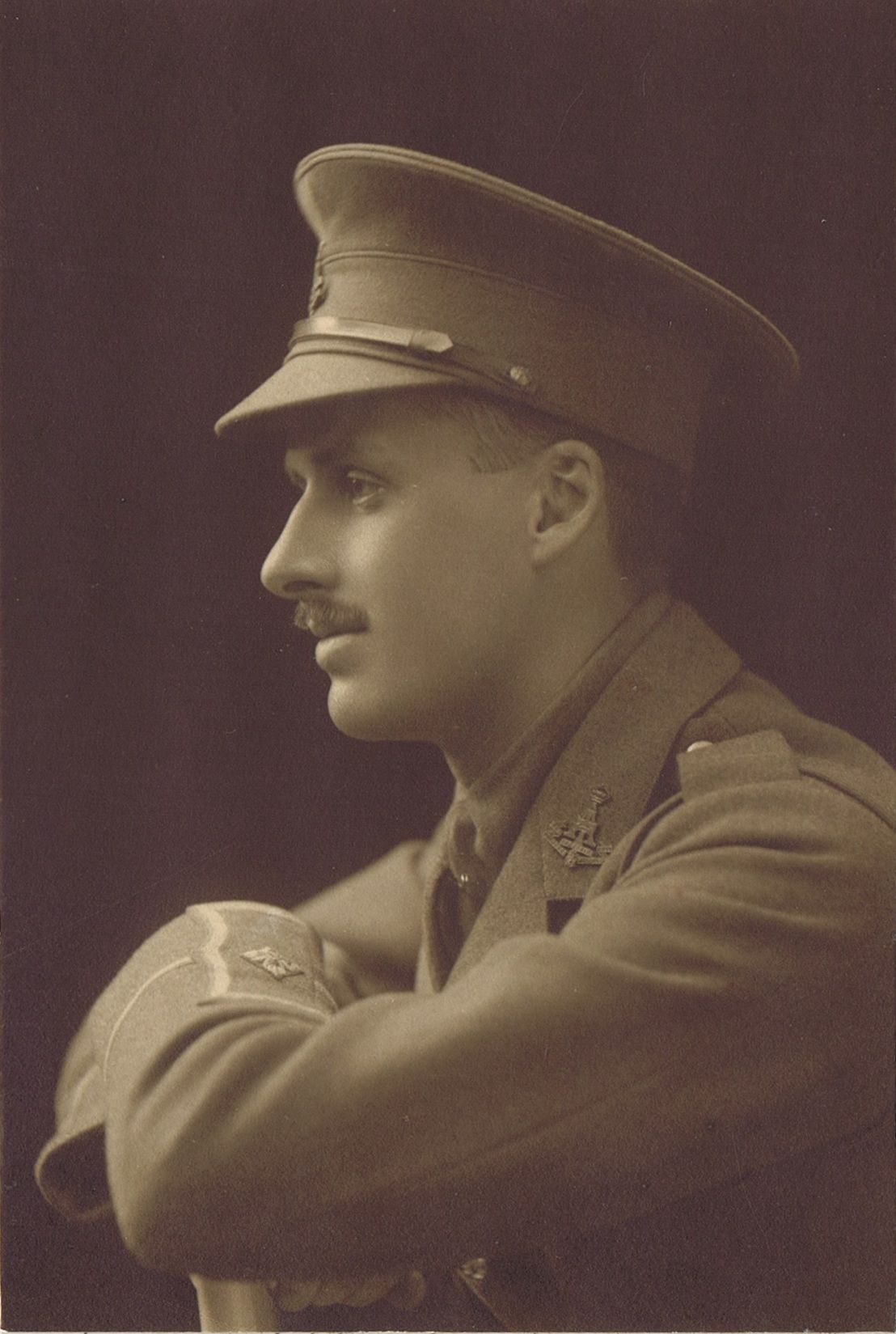
Submitted by Zoe Johnson at the Richmondshire Museum.
Geoffrey Stapleton Rowe Roper
2nd Lieutenant Alexandra Princess of Wales Own, Yorkshire Regiment.
His Canadian service records show that Geoffrey served as a private in Princess Patricia’s Canadian Light Infantry Imperial Army from which he was discharged on the 15th October 1915 to join the Yorkshire Regiment as a 2nd Lieutenant.
He was awarded a Military Cross for conspicuous gallantry in action on the 25th of August 1916 when ‘he held his platoon with great dash in the assault, and afterwards crawled back to the trenches to make a report. He then returned to his platoon being under close and heavy fire’, this extract was taken from the London Gazette.
Serving with the 7th battalion during the Arras offensive of 1917 on May 9th, 2nd Lt Roper and his men were moved into the line in trenches north of the river Scarpe. The battalion were involved in a bitter fighting around Curly and Cupid trenches and had gone into the line with 18 Officers and 436 other ranks and when they came out on May 15th there were only 5 Officers and 228 men left.
2nd Lt G S R Roper MC was killed in this action on May 12th 1917 aged 27. He is remembered on the Cabaret-Rouge British cemetery, Souchez, 7 miles north of Arras.
He was the son of George and Elizabeth Roper of The Lodge, Gilling West, Richmond; his Father being a local magistrate and county Alderman, holding the position of Mayor of Richmond 1881-84 and 1890-91.
He had a sister Miss Ruth G Roper who was Mayor of Richmond 1935-38.
An exhibition about Geoffrey Roper is on display at the Richmondshire Museum.

This image shows the memorial plaque in Gilling West church
Explore more memories from the ribbon
-
Captain M J Kavanagh
Information submitted by Liz Thompson, a resident of Richmond. Michael Joseph Kavanagh (Liz’s Great-Uncle) was born in Walsall, Staffordshire on 20 February 1879. He joined the South Staffordshire Regiment, serving in the Boer War in the Cape Colony, the Transvaal and at Wittegbergin. At the outbreak of the First World War he reenlisted into the same regiment as a Private and advanced to the rank of Colour Sergeant. He was Commissioned as a Second Lieutenant in January 1915 and promoted to Lieutenant in September of the same year. He was wounded twice during the Battle of the Somme and was awarded the Military Cross. The citation published in the London Gazette stated “For conspicuous gallantry during operations. Though knocked over and wounded by a shell, he took over command of a machine gun company two days later, and, suffering from shock and considerable pain, stuck to his command and did good work”. He was promoted to Acting Captain on 8 March 1918. On his retirement in November 1919, Michael Joseph Kavanagh was granted the full rank of Captain. In later life Captain Kavanagh moved into local politics, being elected to the position of Mayor of Walsall in 1945. During the Second World War he served as Platoon Commander of No. 21 Platoon of the 27th Staffordshire Home Guard.
-
Nancy Bainbridge
Story submitted by Mrs Drury, a resident of Richmond. Nancy Bainbridge was born in Weardale, County Durham in May 1894. She was one of eight children whose parents were hardy hill farmers. Nancy was a very practical person and joined Queen Alexandra’s Imperial Military Nursing Service in 1914. Nancy served at a military hospital in East Anglia where the nurses received casualties straight from the Somme. Her upbringing on a farm had afforded her some preparation for the ensuing, distressing sights and sounds. She described how the men arrived with mud and tufts of grass in their wounds. The nurses found out the hard way that soldiers’ skin, subjected to the mustard gas attacks in the trenches, could not be washed with water as that inflicted pain. Nancy received many deathbed requests. After the war Nancy worked as a private nurse in families with disabled soldiers and patients with other conditions. She married Captain Jack (John Adam) Bell. Nancy had a brother William, also a hill farmer and ten years older. He joined the Northumberland Fusiliers, but saw little service because, when detailed to chop an officer some sticks, a splinter blinded him in one eye. Another sibling, Violet, worked in Barnard Castle’s recruiting office. Her soldier husband Harry Raine was awarded the Military Cross. The medal was presented to the Bowes Museum, Barnard Castle.
-
Dixon Overfield
Si Wheeler submitted the story of his great grandfather, Dixon Overfield, but it’s also a great example of the impact of war on all those connected to the soldier who served. “Dixon was married to Margaret and they had a daughter Madge, born in 1915. Dixon enlisted in Filey in September 1916. He originally joined the Royal Field Artillery but soon got transferred to the 6th Battalion, the Yorkshire Regiment. He was sent to France and saw action at Arras, before being moved to Belgium. Dixon survived this fight, but twelve days later he too was killed in action at the Battle of Poelcappelle on the 9th of October 1917 when a shell burst just above himself and several comrades. Their bodies were never recovered. Dixon is remembered on the Tyne Cot Memorial. Dixon’s wife died in 1924, leaving my grandmother, Madge, aged 9, an orphan. Raised by two aunts, then entering service at 13, Madge was taken under the wing of her housekeeper boss, Lizzie Andrew and became part of her extended family. Aged 18, Madge moved to London to train as a nurse, working through the Blitz and marrying a Dunkirk evacuee soldier, my granddad, Harry Wheeler. Harry didn’t mind where they settled to start married life, so they moved to Swanland in East Yorkshire, where Lizzie lived. My parents live there to this day.”
